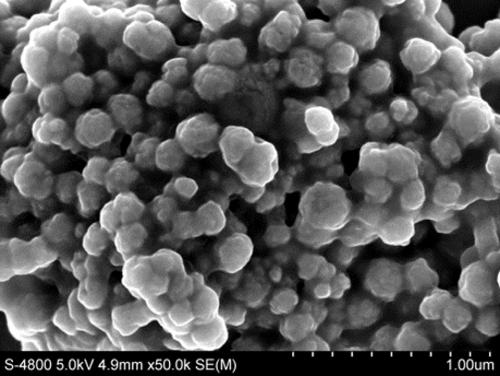Magnetic nanoparticle
A magnetic nanoparticle, responsive technology, used in allergic diseases, wave energy or particle radiation treatment materials, medical preparations of non-active ingredients, etc.
- Summary
- Abstract
- Description
- Claims
- Application Information
AI Technical Summary
Problems solved by technology
Method used
Image
Examples
Embodiment 1
[0171] This embodiment provides a magnetic nanoparticle, the magnetic nanoparticle includes a core, a shell and a halo, the shell covers the core, and the halo covers the shell.
[0172] In some embodiments, the halo further comprises proteins, polypeptides, polysaccharides, aptamers or ions.
[0173] In some embodiments, the halo further comprises a pH responsive group.
[0174] In some embodiments, the pH responsive group responds under neutral or acidic conditions.
[0175] In some embodiments, the pH-responsive groups include hydrazone linkages, ester linkages and aldehyde groups.
[0176] In some embodiments, the protein is selected from transmembrane tetramolecular proteins.
[0177] In some embodiments, the transmembrane tetramolecular protein is selected from one or more of CD9, CD63 and CD81.
[0178] In some embodiments, the polypeptide is selected from CP05.
[0179] In some embodiments, the protein is linked to the halo through the pH responsive group.
[0180...
Embodiment 2
[0213] This embodiment provides a magnetic nanoparticle that can transfer exosomes, and the active ingredient of the magnetic nanoparticle that can transfer exosomes is the magnetic nanoparticle described in Example 1.
[0214] In some embodiments,
[0215] The core of the magnetic nanoparticle of the transferable exosome is ferric oxide,
[0216] The shell of the magnetic nanoparticle of the transferable exosome is silicon dioxide,
[0217] The halo of the magnetic nanoparticles that can transfer exosomes is a hydrazone bond-polyethylene glycol-aldehyde group,
[0218] The antibody of the exosome-transferable magnetic nanoparticle is linked to the halo through an aldehyde group.
[0219] In some embodiments, the antibodies to the magnetic nanoparticles that can transfer exosomes comprise anti-CD63 monoclonal antibodies and anti-MLC monoclonal antibodies.
Embodiment 3
[0221] This embodiment provides a composition comprising magnetic nanoparticles.
[0222] In some embodiments, the magnetic nanoparticles comprise a core, a shell covering the core, and a halo covering the shell.
[0223] In some embodiments, the halo further comprises proteins, polypeptides, polysaccharides, aptamers or ions.
[0224] In some embodiments, the halo further comprises a pH responsive group.
[0225] In some embodiments, the pH responsive group responds under neutral or acidic conditions.
[0226] In some embodiments, the pH-responsive groups include hydrazone linkages, ester linkages and aldehyde groups.
[0227] In some embodiments, the protein is selected from transmembrane tetramolecular proteins.
[0228] In some embodiments, the transmembrane tetramolecular protein is selected from one or more of CD9, CD63 and CD81.
[0229] In some embodiments, the polypeptide is selected from CP05.
[0230] In some embodiments, the protein is linked to the halo throu...
PUM
| Property | Measurement | Unit |
|---|---|---|
| diameter | aaaaa | aaaaa |
| diameter | aaaaa | aaaaa |
| diameter | aaaaa | aaaaa |
Abstract
Description
Claims
Application Information
 Login to View More
Login to View More - R&D
- Intellectual Property
- Life Sciences
- Materials
- Tech Scout
- Unparalleled Data Quality
- Higher Quality Content
- 60% Fewer Hallucinations
Browse by: Latest US Patents, China's latest patents, Technical Efficacy Thesaurus, Application Domain, Technology Topic, Popular Technical Reports.
© 2025 PatSnap. All rights reserved.Legal|Privacy policy|Modern Slavery Act Transparency Statement|Sitemap|About US| Contact US: help@patsnap.com



